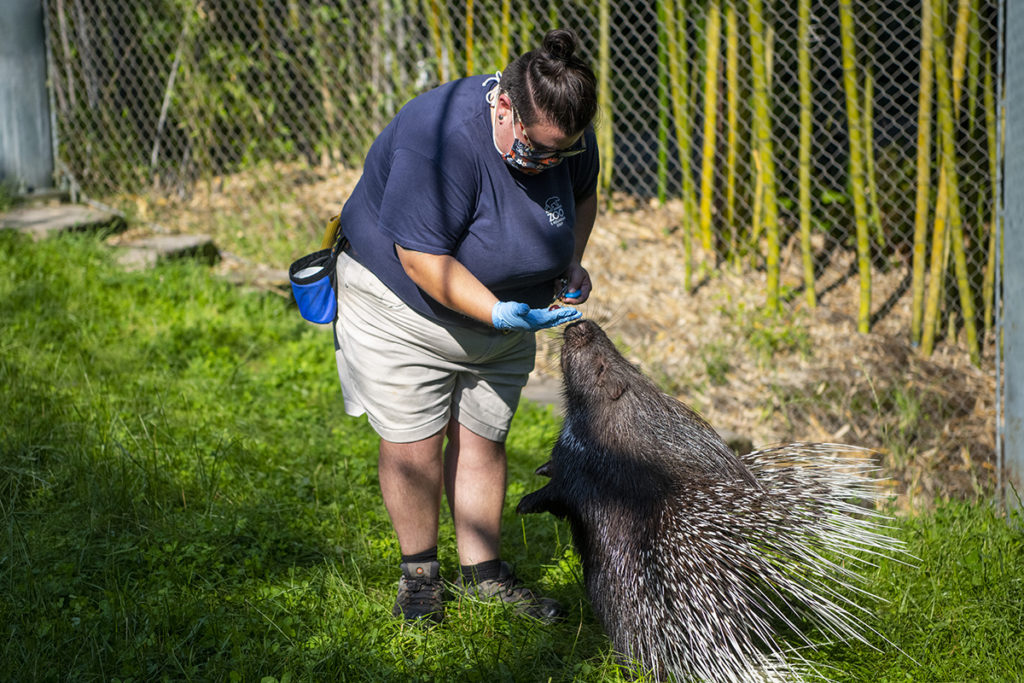Two things make zookeeper life in the Asian Forest Sanctuary quite different from anywhere else at Point Defiance Zoo: lots of meat, and lots of doors. And in a typical day at work, keeper Sam handles both of them with ease – not to mention tigers, tapirs and porcupines.
7:30am
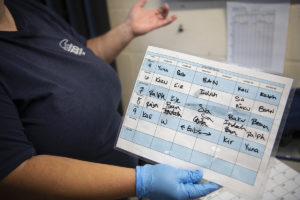
In summer, Sam and her team work four ten-hour days, to allow for their animals to be outside in habitats as long as the Zoo is open – or longer if there are evening events. When she arrives in the morning, the team checks on all animals, then meets to plan who is going where and when – animals AND humans.
Because the Asian Forest Sanctuary is unusual among zoos in that it offers its dozen-plus animals a choice of five different outdoor habitats as well as their evening bedrooms, rotating them in a complicated daily and weekly schedule that allows guests to see all of them – and makes life interesting for all the animals.
“Here’s the plan,” explains Sam, pointing to a large whiteboard map just inside the door that has all habitats marked out, dotted with magnets. “The green magnet names are the animals actually inside those habitats right now. The black magnet names on the edge show who was in there yesterday, so we can keep records and mix it up for the animals.”
Handwritten notes dot the map, and nearby is a weekly chart to make sure everybody’s getting an opportunity to experience different spaces.
“It’s complicated,” smiles Sam happily, clearly relishing the task.
8am
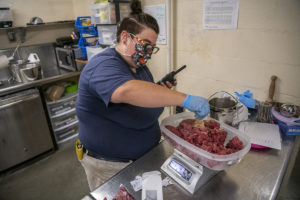
Once the plan’s made, the team’s chores are divvied up and it’s all hands on deck. Diets and vitamins need weighing, chopping, measuring; breakfast needs feeding. Sam scoops a tub for Bandar the tiger: nine pounds of fresh chunk meat. With a total of five Sumatran tigers in residence right now, that’s an awful lot of meat to prepare every morning. Working with one gloved hand, she deftly picks up the Zoo radio in her other and coordinates morning duties.
“Hi!” calls another keeper, grabbing a handful of chopped banana for a gibbon.
Keeper duties also include perimeter checks on all the outdoor habitats – a vital job to make sure fences are secure and nothing harmful is inside.
It’s also a chance to scoop poop, an essential part of zookeeping that helps keepers monitor animal health, track hormones and a host of other useful things.
8:15am
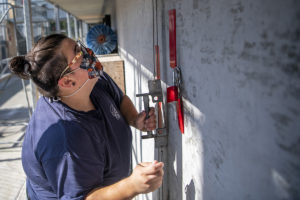
Then the fun begins: moving animals onto exhibit. Connecting the vast area of outdoor habitats with the indoor bedrooms is a complicated maze of chutes – corridors that can be opened or closed off as needed. They run across, above and even under ground, thanks, to the Zoo’s location on sloping terrain, and it takes two keepers to help animals move through the chutes into their day spaces.
Today, Sam’s working with Heather. First comes Whitie the Indian crested porcupine, who’s moving up and into the habitat next to the Asia Day Room.
And here’s where the doors come in.
On ground level, Sam radios Heather to make sure she’s in place. Then she pulls a cable to open some upper doors on the chute, lets herself through two safety doors (shutting them behind her), pulls down a cable and removes some treats the otters have left behind another door.
“We don’t want these treats distracting them,” she explains.
Then as Whitie stands by her own door, Sam opens it and lets Whitie into the chute. The black-and-white porcupine shuffles through, up a ramp, up another ramp, along a bridge over Sam’s head, through the upper corridor and disappears up a final ramp, quills waggling, to where Heather is waiting with treats.
“Yoohoo!” calls Heather, and shuts the door after Whitie, calling down confirmation to Sam.
Below, two golden eyes gleam from a different bedroom – Kali the tiger has been watching every move. Now it’s her turn. She’s going to spend the day in the waterfall habitat, full of lush bamboo, grassy slopes, heated rocks and a waterfall pool.
Nearby, Raja the male tiger gives a low “mrowww”.
Sam and Heather coordinate doors and get into place. This move has a little more potential danger than a porcupine, so Heather calls it out to all Zoo staff on the radio. Then:
“Kali!” calls Sam, in a high voice. “Li-li-li-li! Come on, girl!”
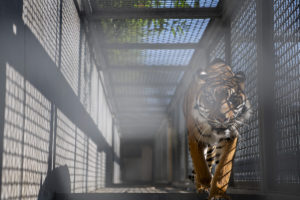
Secure behind several other doors, Heather opens Kali’s door and the tiger pads purposefully through the long overhead corridor – which probably now smells deliciously of porcupine. Stopping briefly to check out the humans, she continues outdoors, instantly peeing on a nearby clump of bamboo.
Sam swiftly shuts the last door and smiles. “Time for gibbons!”
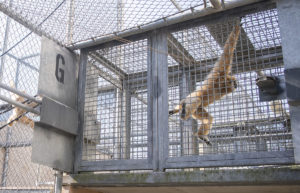
After gibbon brothers Aries and Orion have been moved into the Asia Day Room with more door-coordination and lots of grape rewards, Sam heads into their bedroom to clean up. Some of the poop is green – Aries gets green food dye in his fruit meals, to help keepers distinguish who’s who, healthwise.
“After we move the animals out, we clean their rooms and prepare them for that night,” explains Sam.
But there’s a harder job as well – cleaning the chutes.
“You scrub and disinfect the whole thing bending over,” says Sam. “It’s such a relief when you get out and stand up straight!”
10:30am
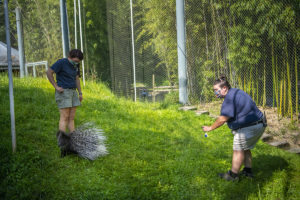
Training time! Sam and colleague Amber head up the keeper stairs and several more doors to rejoin Whitie the porcupine, who sniffs their legs interestedly. Standing ten feet apart, the keepers get to work reinforcing natural behaviors Whitie already does: walking over, standing on hind legs, turning a circle. Each time, she’s rewarded with pellet treats and a click from a hand-held clicker. Whitie’s a very willing partner, but what makes it a little tricky is that porcupines don’t see well.
“They really go by smell, and a little sound,” explains Sam, calling Whitie, jingling keys and waving treats to get her attention.
Has she ever been poked by a quill?
“No,” she says. “We pay close attention to their body language, and they would give us plenty of warning if they were feeling threatened. We have a really good relationship.”
11:30am
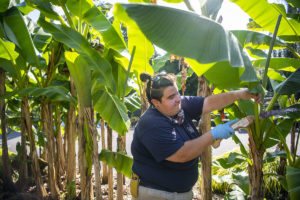
There’s just time to fit in a little browse collection before lunch. Many Zoo animals love the leafy branches grown deliberately for them in the Zoo’s organic browse garden – some love eating them, others like playing, sniffing or just exploring them. Today Sam snips off a couple of banana leaves for Kazu the tapir. The garden’s quiet in the sunlight.
“I actually love cutting browse, it’s very Zen,” Sam says. “And it’s wonderful to learn about all the different plants and how our animals use them.”
1pm
The keeper team eats lunch together, then someone heads out to give a Keeper Chat and others prep animal meals for the afternoon feed. Rooms are made ready with fresh hay, water and other necessities.
The afternoon is also project time: clearing bamboo or making enrichment items, like Kazu’s recent second-birthday treat – a giant number 2 made of papier-mache.
5pm
At Zoo closing time, it’s also time for animals to come off exhibit for the night to stay comfortable and safe. Animal moves happen in reverse, and then keepers can also go home.
“Every day is different,” says Sam. “I like the variety. Our rotational habitats are cool and unique, and I love keeping it fresh for the animals and seeing them enjoy it so much.”
